You are using an out of date browser. It may not display this or other websites correctly.
You should upgrade or use an alternative browser.
You should upgrade or use an alternative browser.
D&D 5E Norse World
- Thread starter Yaarel
- Start date
Yaarel
🇮🇱 🇺🇦 He-Mage
Norse Armor
During the Viking Period, the Norse mainly rely on agility in combat. Combat equipment is well-crafted and allows for fluid movement.
The wooden round shield is a primary defense, while fighting with a one-handed weapon. A warrior might paint the shield with a pattern or image of personal significance. Skald lyrics honor such decorations of shields. Even spear fighters tend to use a shield, thrusting the spear past it one-handed, possibly with versatile use of the shield hand.
Less commonly, a helmet is known, of various styles: dome-shape, crested, and conical, typically with nose guard, sometimes with a spectacle guard.
Archeologists suspect most Norse men and women know how to metalwork, since they appear to make their own iron tools and weapons, while highly skilled metalworkers enjoy celebrated social status. Excellent weapons are a principle means for warriors to display social status.
When present, the chain tunic is light and effective, allowing warriors to perform agile athletic stunts, even swim in it.
While ceremonial burial with weapons is common, burial in armor is rare. Prized swords are sometimes ‘killed’ (ceremonially damaged) to discourage looting, sometimes left whole. Possibly, metal helmets and chain tunics lack ritual significance, and are more likely to pass down to the next generation of warriors. Burial sites increase in frequency where a warrior was killed while wearing a chain tunic (evidenced by a lethal leg wound), yet is buried without a chain tunic.
Leather armor appears unknown among the Norse, except for foreign items.
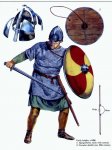
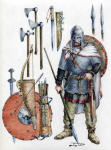



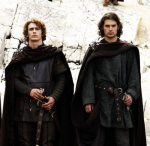
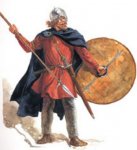
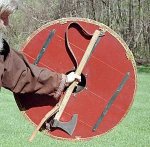

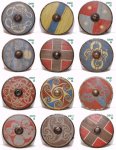
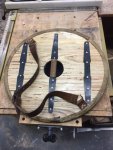


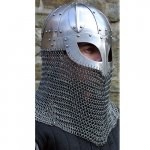
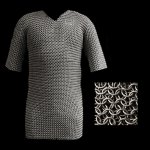
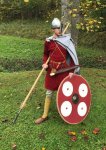
A woman warrior, nicknamed a ‘shield lass’ skjaldmær, probably dresses according to personal preference. Possibly she wears a heavy linen, ankle-length underdress (with added side slits or extra material gores to flair wide for lots of leg room), then over it, thigh-length versions of dresses (resembling mens tunics). Wearing mens tunics seems possible, yet drawings of valkyrjur suggest women warriors prefer womens clothing, as long as conducive to battle. Descriptions mention the normal use of shield and helmet, and occasional references to the brynja chain tunic.
Below are warriors from Noregr 800s, the Oseberg Tapestry. In the first image, two women warriors in traditional womens clothing, each carrying a spear. They appear dressed in an ankle-length underdress, with a cape around shoulders and reaching the ankles, and a scarf to tie back the hair. Men in the tapestry wear either Norse pants or Garðariki baggy pants, bound calf-length. In the next image, these might be unbound baggy pants, but the form disresembles the other examples. Possibly, this is a woman spearfighter, in an ankle-length linen underdress, and over it, a thigh-length version of a longsleeve heavy wool dress. An other warrior may be a similarly clad woman carrying a sword. In this case, note the similarity between what appears to be a womens underdress (serkr) on the warrior, and what is clearly a womens underdress on the woman to the right of the warrior. A modern reconstruction is perhaps suggestive. She can easily wear a brynja chain tunic over these. Elsewhere a woman appears in a Viking Period carving in England, wearing the distinctive Viking outer dress (smokkr) with the traditional shoulder-strap ornaments, but only thigh-length rather than the normal calf-length. Thigh-length versions of womens dresses seem possible and useful for combat.





Note, in the armor statistics below, the helmet is treated as a separate item that adds an AC helmet bonus +1, mechanically similar to the AC shield bonus +2. A cloak or cape likewise can boost AC.
To make more sense of the light but wellmade brynja chain tunic, being shortsleeve thigh-length, the 3e mechanic for the light armor chain shirt represents it allowing Dexterity bonus +4. Mix-and-match armor types. For example, Dexterity +3, with Skjǫldr wooden round shield +2, Hjálmr helmet +1, and Brynja chain tunic AC 13, totals AC 19.
NORSE ARMOR
Cloth Armor
Kyrtlar (mens heavy tunics of linen or wool) light armor
AC 11 + Dexterity bonus
Serkir (womens heavy dresses of linen or wool) light armor
AC 11 + Dexterity bonus
Feldr (mens heavy wool cloak, open to side, broach on shoulder)
AC +1
Skikkja (womens heavy wool cape, open at front, broach in front below neck)
AC +1
Shield
Skjǫldr (wooden round shield)
AC +2
Helmet
Hjálmr (helmet, dome shaped, crested, or conical, with spectacle or nose guard)
AC +1
Chain Armor
Brynja (shortsleeve thigh-length chain tunic, over tunics or dresses) light armor
AC 13 + maximum Dexterity bonus +4
Because of traderoutes, Non-Norse armors are possible
(Finnar calf-length fur tunic for shaman) light armor
AC 12 + Dexterity bonus
(Garðariki lamellar scale cuirass) medium armor
AC 14 + maximum Dexterity bonus +2
(Frakkland longsleeve calf-length hauberk chain suit) heavy armor
AC 16 + No Dexterity bonus
During the Viking Period, the Norse mainly rely on agility in combat. Combat equipment is well-crafted and allows for fluid movement.
The wooden round shield is a primary defense, while fighting with a one-handed weapon. A warrior might paint the shield with a pattern or image of personal significance. Skald lyrics honor such decorations of shields. Even spear fighters tend to use a shield, thrusting the spear past it one-handed, possibly with versatile use of the shield hand.
Less commonly, a helmet is known, of various styles: dome-shape, crested, and conical, typically with nose guard, sometimes with a spectacle guard.
Archeologists suspect most Norse men and women know how to metalwork, since they appear to make their own iron tools and weapons, while highly skilled metalworkers enjoy celebrated social status. Excellent weapons are a principle means for warriors to display social status.
When present, the chain tunic is light and effective, allowing warriors to perform agile athletic stunts, even swim in it.
While ceremonial burial with weapons is common, burial in armor is rare. Prized swords are sometimes ‘killed’ (ceremonially damaged) to discourage looting, sometimes left whole. Possibly, metal helmets and chain tunics lack ritual significance, and are more likely to pass down to the next generation of warriors. Burial sites increase in frequency where a warrior was killed while wearing a chain tunic (evidenced by a lethal leg wound), yet is buried without a chain tunic.
Leather armor appears unknown among the Norse, except for foreign items.
















A woman warrior, nicknamed a ‘shield lass’ skjaldmær, probably dresses according to personal preference. Possibly she wears a heavy linen, ankle-length underdress (with added side slits or extra material gores to flair wide for lots of leg room), then over it, thigh-length versions of dresses (resembling mens tunics). Wearing mens tunics seems possible, yet drawings of valkyrjur suggest women warriors prefer womens clothing, as long as conducive to battle. Descriptions mention the normal use of shield and helmet, and occasional references to the brynja chain tunic.
Below are warriors from Noregr 800s, the Oseberg Tapestry. In the first image, two women warriors in traditional womens clothing, each carrying a spear. They appear dressed in an ankle-length underdress, with a cape around shoulders and reaching the ankles, and a scarf to tie back the hair. Men in the tapestry wear either Norse pants or Garðariki baggy pants, bound calf-length. In the next image, these might be unbound baggy pants, but the form disresembles the other examples. Possibly, this is a woman spearfighter, in an ankle-length linen underdress, and over it, a thigh-length version of a longsleeve heavy wool dress. An other warrior may be a similarly clad woman carrying a sword. In this case, note the similarity between what appears to be a womens underdress (serkr) on the warrior, and what is clearly a womens underdress on the woman to the right of the warrior. A modern reconstruction is perhaps suggestive. She can easily wear a brynja chain tunic over these. Elsewhere a woman appears in a Viking Period carving in England, wearing the distinctive Viking outer dress (smokkr) with the traditional shoulder-strap ornaments, but only thigh-length rather than the normal calf-length. Thigh-length versions of womens dresses seem possible and useful for combat.





Note, in the armor statistics below, the helmet is treated as a separate item that adds an AC helmet bonus +1, mechanically similar to the AC shield bonus +2. A cloak or cape likewise can boost AC.
To make more sense of the light but wellmade brynja chain tunic, being shortsleeve thigh-length, the 3e mechanic for the light armor chain shirt represents it allowing Dexterity bonus +4. Mix-and-match armor types. For example, Dexterity +3, with Skjǫldr wooden round shield +2, Hjálmr helmet +1, and Brynja chain tunic AC 13, totals AC 19.
NORSE ARMOR
Cloth Armor
Kyrtlar (mens heavy tunics of linen or wool) light armor
AC 11 + Dexterity bonus
Serkir (womens heavy dresses of linen or wool) light armor
AC 11 + Dexterity bonus
Feldr (mens heavy wool cloak, open to side, broach on shoulder)
AC +1
Skikkja (womens heavy wool cape, open at front, broach in front below neck)
AC +1
Shield
Skjǫldr (wooden round shield)
AC +2
Helmet
Hjálmr (helmet, dome shaped, crested, or conical, with spectacle or nose guard)
AC +1
Chain Armor
Brynja (shortsleeve thigh-length chain tunic, over tunics or dresses) light armor
AC 13 + maximum Dexterity bonus +4
Because of traderoutes, Non-Norse armors are possible
(Finnar calf-length fur tunic for shaman) light armor
AC 12 + Dexterity bonus
(Garðariki lamellar scale cuirass) medium armor
AC 14 + maximum Dexterity bonus +2
(Frakkland longsleeve calf-length hauberk chain suit) heavy armor
AC 16 + No Dexterity bonus
Last edited:
Grainger
Explorer
Mail armour was extremely labour-intensive to make (at least in later medieval times, but surely it would also be for the Norse). Perhaps that's a factor in why they often didn't bury it with the dead warrior. Although that doesn't explain a lack of helmets being interred with their owners.
Yaarel
🇮🇱 🇺🇦 He-Mage
Not attempting to push your buttons here, but how are you coping with the whole Norse polytheism thing?
Mainly,
Norway animism,
Germany polytheism,
Denmark is a mix.
Sweden is apparently animistic, like Norway. Today, Swedish archeologists doubt the veracity of alleged polytheism in Uppsala, as claimed by Adam of Bremen, a German Christian.
One difference between animism and polytheism is, animism is a horizontal egalitarian worldview of neighboring nature spirits, whereas polytheism is a vertical hierarchical worldview of masters and servants.
Aldarc
Legend
I don't know. This sounds like these archaeologists are attempting to position Norse religion as Norse exceptionalism that lies distinctly separate from similar religious forms from continental Germanic peoples.Mainly,
Norway animism,
Germany polytheism,
Denmark is a mix.
Sweden is apparently animistic, like Norway. Today, Swedish archeologists doubt the veracity of alleged polytheism in Uppsala, as claimed by Adam of Bremen, a German Christian.
One difference between animism and polytheism is, animism is a horizontal egalitarian worldview of neighboring nature spirits, whereas polytheism is a vertical hierarchical worldview of masters and servants.
Yaarel
🇮🇱 🇺🇦 He-Mage
I don't know. This sounds like these archaeologists are attempting to position Norse religion as Norse exceptionalism that lies distinctly separate from similar religious forms from continental Germanic peoples.
The word ‘Germanic’ is Non-Norse. It feels alien to Scandinavians.
Indeed, the concept of a ‘Germanic people’ is a fiction invented by Romantic Era German scholars. Humorously, the tribe that the Romans referred to as the Germanii is probably an unrelated Celtic tribe.
The Norse share linguistic influences with other ethnic groups, but these influences occurred during prehistoric periods. The transmission of these languages across genetically diverse ethnic groups still requires scientific explanations. To some degree, the influences are Scandinavian radiating outward. In any case, the respective ethnic groups continue to evolve differently. Various cognate terms mean different things in different languages. These are diverse ethnicities, with different genetic modalities, different cultures, different spiritualities, different experiences, and different influential neighbors.
Across the traderoutes of the Viking Period, Danmǫrk shares mutual influences with Saxland (today Germany) and even farther south to Roma. However Noregr and Svíþjóð share mutual influences with the Finnar (today Sámi and Suoma). Additionally, Noregr shares mutual influences with Írland and Skotland, and Svíþjóð shares mutual influences with Garðariki (today Russia and Ukraine).
The Norse themselves largely constitute the aborigines of Europe relating to Cro-Magnon. (Note the high frequency of yDNA I1.) These prehistoric aborigines appear to be the origin of the unusually light complexion. Via the sustenance of hunting and gathering and fishing, the Norse preserved their aboriginal hunter-gatherer ways of life, including their animistic worldview. In the Viking Period, the Norse and the Finnar share similar non-urban worldviews. Both revere shamans as their only spiritual leaders (vǫlva and noaidi, respectively). Even today, there are Scandinavians who have experienced encounters with nature spirits, such as hulder and tusse. Icelanders similarly. In the psyche of the Norse, natural phenomena are mindful presences.
At worst, the use of the term ‘Germanic’ recalls the horror of N*zi German imperialism trying to appropriate Norse cultural symbols. At best, the term is scientifically inaccurate and a misnomer that misrepresents Norse identity.
More usefully, the term Norse relates to the term Norsk, and derives ultimately from the Old Norse term, Norrœnn, and accurately represents the aboriginal ethnic identity.
Last edited:
Yaarel
🇮🇱 🇺🇦 He-Mage
Norse sacred traditions are a network overlapping local traditions. What is central to one location might be unknown in an other location. Even where two locations share a cognate concept, their contexts and meanings differ.
This relativity is especially true where there are points of contact between Norse and other ethnic groups.
For example, the Norse term alfr is cognate with the Old English term ælf. However the British context of French faie and Celtic sidhe, plus an emerging concept of faierie magic, perceive the British ælf as a nocturnal land spirit, quite unlike the Norse sunlight spirit.
What the alfr and the ælf have in common is a personification of superhuman beauty, sexuality, fate, and magic.
This relativity is especially true where there are points of contact between Norse and other ethnic groups.
For example, the Norse term alfr is cognate with the Old English term ælf. However the British context of French faie and Celtic sidhe, plus an emerging concept of faierie magic, perceive the British ælf as a nocturnal land spirit, quite unlike the Norse sunlight spirit.
What the alfr and the ælf have in common is a personification of superhuman beauty, sexuality, fate, and magic.
TheCosmicKid
Hero
I'm not in the mood for an argument, so I'm just going to call this the Standard Yaarel Warning:
Be aware that many of the claims about medieval Scandinavian history, culture, and (especially) religious belief which Yaarel states as settled fact are actually regarded as speculative, contentious, or even fringe theories among the historical community. The archeological and textual record of the Norse, much like any pre-modern society, is vague and open to many different interpretations. Exercise caution and think critically.
Be aware that many of the claims about medieval Scandinavian history, culture, and (especially) religious belief which Yaarel states as settled fact are actually regarded as speculative, contentious, or even fringe theories among the historical community. The archeological and textual record of the Norse, much like any pre-modern society, is vague and open to many different interpretations. Exercise caution and think critically.
Similar Threads
- Replies
- 7
- Views
- 1K
- Replies
- 13
- Views
- 1K
- Replies
- 26
- Views
- 7K
- Replies
- 71
- Views
- 10K
